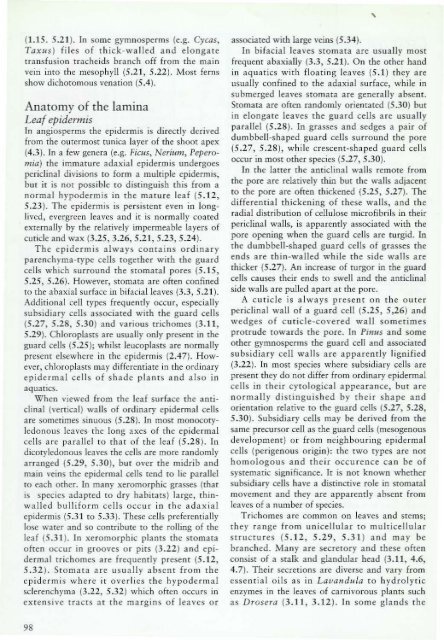You also want an ePaper? Increase the reach of your titles
YUMPU automatically turns print PDFs into web optimized ePapers that Google loves.
(1.15.5.21). In some gymnosperms (e.g. Cycas,<br />
Taxl/s) files of thick-walled and elongate<br />
transfusion tracheids branch off from the main<br />
vein into the mesophyl1 (S.21, 5.22). Most ferns<br />
show dichotomous venation (5.4).<br />
Anatomy of the lamina<br />
Leafepidennis<br />
In angiosperms the epidermis is directly derived<br />
from the outermost tunica layer of the shoot apex<br />
(4.3). In a few genera (e.g. Ficus, Neriflm, Peperomia)<br />
the immature adaxial epidermis undergoes<br />
pcriclinal divisions to form a multiple epidermis,<br />
but it is not possible to distinguish this from a<br />
normal hypodermis in the mature leaf (5.12,<br />
5.23). The epidermis is persistent even in longlived,<br />
evergreen leaves and it is normally coated<br />
exu:rnally by the relatively impermeable layers of<br />
cuticle and wax (3.25, 3_26, 5.21, 5.23, 5.24).<br />
The epidermis always contains ordinary<br />
patenchyma-type cells together with the guard<br />
cells which surround the stomatal pores (5.15,<br />
5.25,5.26). However, stOmata are often confined<br />
to the abaxial surface in bifacial leaves (3.3, 5.2t).<br />
AddiTional cell types frequendy occur, especially<br />
subsidiar}' cells associaTed with the guard cells<br />
(5.27, 5.28, 5.30) and various rrichomes (3.lt,<br />
5.29). Chloroplasts are usually only present in me<br />
guard cells (5.2S); whilst leucoplastS are normally<br />
preseO[ elsewhere in the epidermis (2,47). However,<br />
chloroplasts may differentiate in the ordinary<br />
epidermal cells of shade plants and also in<br />
aquatics.<br />
\Vhen viewed from the leaf surface the anticlinal<br />
(vertical) walls of ordinary epidermal cells<br />
are sometimes sinuous (5.28). In most monocotyledonous<br />
leaves the long axes of the epidermal<br />
cells arc parallel to that of the leaf (5.28). In<br />
dicotyledonous leaves the cells are more randomly<br />
arranged (5.29, 5.30), but over the midrib and<br />
main veins the epidermal cells tend to lie parallel<br />
to each other. In many xeromorphic grasses (that<br />
is species ad:lpted to dry habitats) large, thinwalled<br />
bulliform cells occur in rhe adaxial<br />
epidermis {5.3l to 533}. These cells preferentially<br />
lose water and so contribute to the rolling of the<br />
leaf (5.31). In xeromorphic plants the stOmata<br />
often occur in grooves or pits (3.22) and epidermal<br />
trichames are frequently present (5.12,<br />
5.32). Stomata are usually absent from the<br />
epidermis where it overlies the hypodermal<br />
sclerenchyma (3.22, 5.32) which often occurs in<br />
extensive tracts at the margins of leaves or<br />
98<br />
associated with large veins (5.34).<br />
In bifacial leaves Stomata are usually mOSt<br />
frequent abaxially (3.3, 5.21). On the other hand<br />
in aquatics with floating leaves {5.l} they are<br />
usually confined to the adaxial surface, while in<br />
submerged leaves Stomata are generally absent.<br />
Stomata are often randomly orientated (5.30) but<br />
in elongate leaves the guard cells arc usually<br />
parallel (5.2S). In grasses and sedges a pair of<br />
dumbbell-shaped guard cells surround the pore<br />
(5.27, 5.28), while crescent-shaped guard cells<br />
occur in most other specits (5.27, 5.30).<br />
In the latter the anticlinal walls rtmote from<br />
the pore are relatively thin but the walls adjacent<br />
to the pore are often thickened (5_25, 5.27). The<br />
differential thickening of these walls, and the<br />
radial distribution of cellulose microfibrils in their<br />
pericJinal walls, is apparently associated with the<br />
pore opening when the guard cells are turgid. In<br />
the dumbbell-shaped guard cells of gtasses the<br />
ends are thin-walled while the side walls are<br />
thicker (S.27). An increase of turgor in the guard<br />
cells causes their ends to swell and the anticlinal<br />
side walls are pulled apart at the pore.<br />
A cuticle is always present on the outer<br />
periclinal wall of a guard cell (5.25, 5,26) and<br />
wedges of cuticle-covered wall sometimes<br />
protrude towards the pore. In PinllS and some<br />
other gymnosperms the guard cell and associated<br />
subsidiary cell walls are apparendy lignified<br />
(3.22). In most species where subsidiary cells are<br />
present they da not differ from ordinary epidermal<br />
cells in their cytological appearance, but arc<br />
normally distinguished by their shape and<br />
orientation relative to the guard cells (5.27, 5_28,<br />
5.30). Subsidiary cells may be derived from the<br />
same precursot cell as the guard cells (mesogenous<br />
development) or from neighbouring epidermal<br />
cells (perigenous origin): the two types are not<br />
homologous and their occurence can be of<br />
systematic significance. It is not known whether<br />
subsidiary cells have a distinctive role in stomatal<br />
movement and they are apparently absent from<br />
leaves of a number of species.<br />
Trichomes are COmmon on leaves and stems;<br />
they range fram unicellular to multicellular<br />
structures (5.12, 5.29, 5.31) and may be<br />
branched. Many are secretory and these oftcn<br />
consist of a stalk and glandular head (3.n, 4.6,<br />
4.7). Their secretions are diverse and vary from<br />
essential oils as in Lavandllla to hydrolytic<br />
enzymes in the leaves of carnivorous plants such<br />
as Drosera (3.11, 3.12). In some glands the<br />
,





